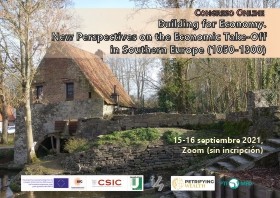Congress "Building for Economy. New Perspectives on the Economic Take-Off in Southern Europe (1050-1300)"
Evento online a través de Zoom. Sin inscripción.
Participan, entre otros, Almudena Blasco (IH-CSIC) y Jordi Morelló (IH-CSIC)
Este congreso se centra en el desarrollo económico examinando la relación entre las inversiones en construcción, por un lado, y la producción y el comercio, por otro. Se pretende centrar la atención en los edificios que tenían como finalidad principal el servicio a la economía, en todos sus aspectos: la actividad agrícola y los procesos de conservación y transformación de sus productos, la artesanía, los intercambios y las infraestructuras materiales que los hacían posibles. En efecto, el crecimiento constante que se produjo entre 1050 y 1300 se tradujo en una multiplicación de estructuras estrechamente vinculadas a la actividad económica (como molinos, canales, arsenales, puentes, etc.), a menudo asociadas a una importante transformación material de sus formas. Centrarse en las dinámicas vinculadas a estos edificios puede ofrecer un punto de vista privilegiado para leer los tiempos, los ritmos y las características del despegue económico en el sur de Europa, en particular para la fase oscura anterior a 1200.
Organiza: Proyecto ERC Petrifying Wealth. The Southern European Shift to Masonry as Collective Investment in Identity, c. 1050-1300
As part of the ERC project Petrifying Wealth. The Southern European Shift to Masonry as Collective Investment in Identity, c. 1050-1300, the Building for Economy. New perspectives on the Economic take off in Southern Europe (1050-1300) conference focuses on economic development by examining the relationship between investments on buildings on the one hand, production and trade on the other. The intent is to focus on buildings that had as their main purpose the service to the economy, in all its aspects: agricultural activity and the processes of conservation and processing of its products, crafts, exchanges and the material infrastructures that made them possible. The steady growth that occurred between 1050 and 1300 resulted indeed in a multiplication of structures closely connected with economic activity (such as mills, canals, arsenals, bridges, etc.) often associated with a significant material transformation of their material forms. Focusing on the dynamics connected to these buildings can offer a privileged vantage point for reading times, rhythms and characteristics of economic take-off in southern Europe, in particular for the obscure phase prior to 1200




